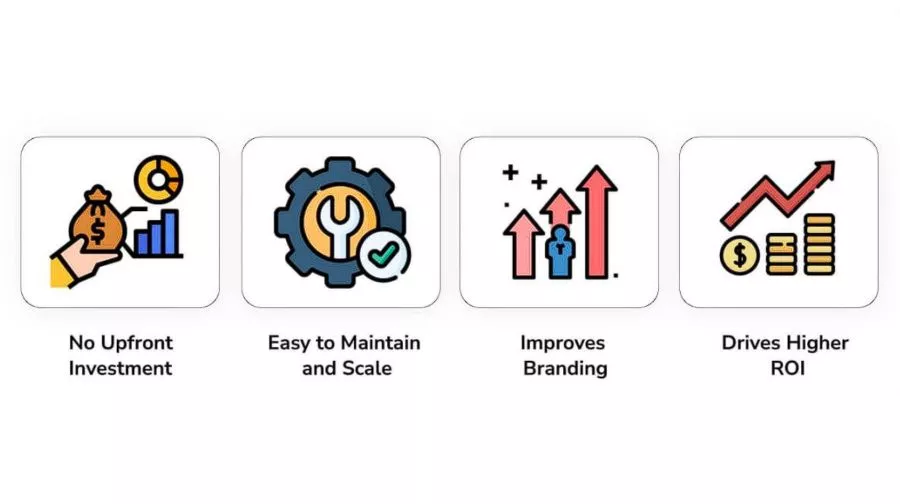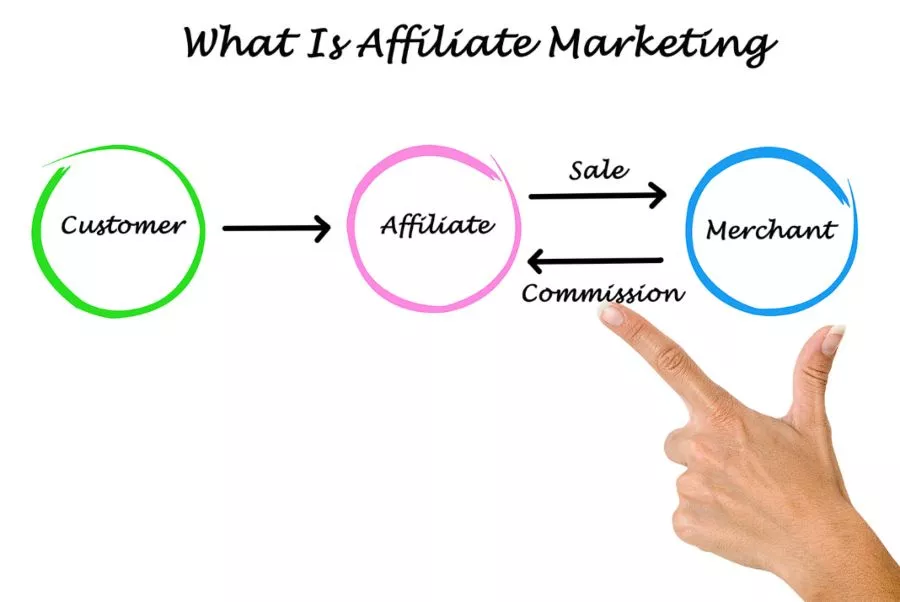Affiliate Marketing 101: How to Get Started

Contents
- 1 Introduction
- 2 What is Affiliate Marketing?
- 3 Understanding Affiliate Marketing: Unpacking the Basics and Key Components
- 4 Benefits of Affiliate Marketing
- 5 Setting the Foundation for Successful Affiliate Marketing
- 6 Building an Effective Affiliate Website
- 7 Joining Affiliate Programs
- 8 Creating Quality Content
- 9 Mastering SEO for Affiliate Marketing Success
- 10 Leveraging Social Media for Affiliate Marketing
- 11 Email Marketing for Affiliates
- 12 Analyzing and Tracking Performance
- 13 Building Trust with Your Audience
- 14 Scaling Your Affiliate Marketing Business
- 15 Challenges and Solutions
- 16 Legal and Ethical Considerations in Affiliate Marketing
- 17 Future Trends in Affiliate Marketing
- 18 Conclusion
- 19 Frequently Asked Questions (FAQs)
- 19.1 Q1: What is affiliate marketing and how does it work?
- 19.2 Q2: How can I start in affiliate marketing if I’m new to it?
- 19.3 Q3: Is it necessary to have a website for affiliate marketing?
- 19.4 Q4: How do I build trust with my audience in affiliate marketing?
- 19.5 Q5: What are the future trends in affiliate marketing?
Introduction
In the bustling ecosystem of online commerce, affiliate marketing stands out as a transformative force, reshaping the dynamics of how businesses connect with their target audiences. This segment delves into the intricacies of affiliate marketing, shedding light on its essence and exploring its paramount significance in the contemporary digital sphere.
What is Affiliate Marketing?
At its core, affiliate marketing represents a performance-based strategy that fosters collaboration between businesses and individuals known as affiliates. The essence of this dynamic lies in rewarding affiliates for their role in directing traffic and generating sales for the products or services of the affiliated businesses. In simpler terms, it encapsulates a mutually beneficial relationship where affiliates leverage their unique platforms to promote products, earning commissions for every successful sale attributed to their promotional efforts.
Imagine you run a blog and passionately recommend a stellar product to your readers. Through the mechanics of affiliate marketing, you seamlessly embed special tracking links within your content. As your readers engage with these links and proceed to make purchases, you, as the affiliate, earn a commission. This straightforward and symbiotic exchange exemplifies the essence of affiliate marketing – a synergy where businesses gain exposure and revenue, and affiliates monetize their influence.
Importance in the Digital Landscape
Affiliate marketing has ascended to a pivotal position within the expansive realm of digital marketing, a status earned through its multifaceted advantages and contributions to online business strategies. Its significance unfolds on several fronts.
Firstly, affiliate marketing offers an economically efficient avenue for businesses to extend their digital footprint. Instead of deploying substantial resources in traditional advertising, companies can harness the diverse and expansive networks of affiliates. This strategic approach allows businesses to tap into niche markets they might otherwise struggle to access, achieving a broader reach with minimal financial outlay.
Furthermore, the digital landscape thrives on the pillars of trust and peer recommendations. Consumers increasingly base their purchasing decisions on personal endorsements or reviews from trusted sources. Affiliate marketing brilliantly aligns with this consumer behavior, as affiliates, often enthusiasts or experts in their respective niches, share authentic experiences and insights. This transparent engagement creates a bridge of trust between the brand and the consumer, elevating the likelihood of conversion.
In the sprawling expanse of online content, affiliate marketing brings a targeted precision to advertising efforts. Businesses can meticulously focus on specific audience segments by leveraging affiliates who have already cultivated a loyal following within particular niches. This precision not only enhances conversion rates but ensures that marketing endeavors are directed towards those most likely to express genuine interest in the promoted product or service.
Affiliate marketing transcends conventional marketing strategies; it emerges as a potent tool that empowers businesses to thrive amidst the dynamic currents of the digital landscape. As we embark on a more detailed exploration of affiliate marketing, we will unravel the nuanced strategies, manifold benefits, and potential challenges that define this captivating and evolving facet of the digital marketing spectrum.
Understanding Affiliate Marketing: Unpacking the Basics and Key Components
Delving into the world of affiliate marketing requires a comprehensive grasp of its fundamental elements. In this segment, we unravel the basics of affiliate marketing, providing insight into its definition, historical context, and the key components that form the foundation of this dynamic digital strategy.

Basics of Affiliate Marketing
Definition and Concept
Affiliate marketing, in its essence, is a collaborative marketing approach where businesses reward individuals, known as affiliates, for driving traffic or sales to their products through the affiliate’s marketing efforts. It’s essentially a performance-based model, where compensation is tied to measurable outcomes, such as clicks, leads, or actual purchases. Picture it as a digital partnership: businesses benefit from increased exposure and sales, while affiliates earn commissions for their role in the promotional process.
Historically, the roots of affiliate marketing can be traced back to the mid-1990s when it emerged as a solution to the challenges of traditional advertising. The model has evolved over time, adapting to the changing landscape of digital commerce and leveraging technological advancements to become the sophisticated and widespread practice it is today.
Key Components
1. Merchants
Merchants, also known as advertisers or vendors, are the businesses that own the products or services being promoted through affiliate marketing. These entities seek to expand their market reach by partnering with affiliates who can effectively showcase their offerings to a broader audience. Merchants provide affiliates with unique tracking links that attribute sales or traffic generated through affiliate efforts, enabling precise measurement of the campaign’s success.
2. Affiliates
Affiliates are the driving force behind affiliate marketing. These individuals or entities actively promote products or services on behalf of merchants in exchange for commissions. Affiliates come in various forms, including bloggers, social media influencers, and website owners. Their influence and reach within specific niches make them valuable partners for merchants seeking targeted exposure. The success of an affiliate hinges on their ability to authentically endorse products and effectively persuade their audience to take desired actions, be it making a purchase or clicking a link.
3. Consumers
At the heart of affiliate marketing are the consumers – the individuals who ultimately engage with the promoted products or services. Consumers may come across affiliate-promoted content on blogs, social media platforms, or other online channels. What sets affiliate marketing apart is its ability to connect consumers with products through the trusted recommendations of affiliates. The model relies on building trust between the affiliate and their audience, fostering a genuine interest in the endorsed offerings.
As we unravel the intricacies of affiliate marketing, these foundational elements lay the groundwork for a symbiotic relationship that extends beyond traditional advertising. In the subsequent sections, we’ll explore the strategies employed by affiliates, the mechanics of tracking and commission structures, and the evolving landscape of consumer engagement within the realm of affiliate marketing.
Benefits of Affiliate Marketing
Embarking on the journey of affiliate marketing brings forth a plethora of benefits for all stakeholders involved. In this section, we unravel the distinct advantages that affiliate marketing offers to merchants, affiliates, and consumers alike.

Advantages for Merchants
Merchants, the driving force behind the products or services, reap several benefits through the adoption of affiliate marketing strategies.
1. Cost-Effective Advertising:
Affiliate marketing operates on a performance-based model, ensuring that merchants only pay for actual results, such as clicks or sales. This cost-effective approach stands in contrast to traditional advertising, where upfront expenses may not guarantee tangible outcomes.
2. Extended Reach and Exposure:
By partnering with a network of affiliates, merchants tap into diverse and niche audiences that might be challenging to access through conventional marketing channels. This broadens the reach of their products or services, potentially leading to increased brand visibility and market share.
3. Risk Mitigation:
The risk in affiliate marketing is distributed. Merchants only incur costs when desired actions occur, minimizing financial risks associated with advertising. This aspect is particularly beneficial for small and medium-sized businesses aiming to maximize their marketing impact within budget constraints.
Benefits for Affiliates
Affiliates, the champions of product promotion, find a multitude of advantages in the affiliate marketing landscape.
1. Lucrative Income Opportunities:
Affiliates earn commissions for every successful lead, click, or sale generated through their promotional efforts. This commission-based structure offers affiliates the potential for a lucrative income stream, particularly as their audience grows and trust in their recommendations solidifies.
2. Flexibility and Autonomy:
Affiliate marketing provides a flexible work environment. Affiliates have the autonomy to choose products or services aligned with their interests and the preferences of their audience. This flexibility allows them to curate content that resonates authentically with their followers, enhancing the effectiveness of their promotional efforts.
3. Low Barrier to Entry:
Unlike some business ventures that require significant upfront investment, becoming an affiliate marketer typically involves minimal costs. This low barrier to entry democratizes the field, allowing individuals with diverse backgrounds and resources to participate and thrive in the affiliate marketing ecosystem.
Value Proposition for Consumers
At the core of affiliate marketing is the end consumer, who stands to gain in several ways:
1. Informed Purchase Decisions:
Consumers benefit from affiliate marketing through access to authentic reviews and recommendations. Affiliates often share personal experiences with the products or services they promote, empowering consumers to make informed purchase decisions based on real-world insights.
2. Access to Niche Products:
The diverse landscape of affiliates means that consumers can discover niche products or services that may not be prominently featured in mainstream advertising. This variety allows consumers to explore unique offerings that cater to their specific needs or interests.
3. Trustworthy Recommendations:
The relationship of trust between affiliates and their audience is pivotal. Individuals are inclined to place greater trust in recommendations from people they follow and hold in high regard. Affiliate marketing thrives on building and maintaining this trust, ensuring that consumers receive genuine and trustworthy endorsements.
As we navigate the landscape of affiliate marketing benefits, it becomes evident that this model creates a harmonious ecosystem where each participant gains in a symbiotic relationship. The subsequent sections will delve into the strategies employed by merchants and affiliates to maximize these advantages, illustrating the dynamic nature of affiliate marketing in action.
Setting the Foundation for Successful Affiliate Marketing
Before embarking on the affiliate marketing journey, a solid foundation is essential. This section illuminates the critical steps in this foundational phase, outlining the significance of choosing a niche, selecting profitable products or services, and thoroughly researching the target audience.

Choosing a Niche
1. Define Your Passion and Expertise:
The journey begins by identifying a niche that aligns with your passion and expertise. Whether it’s technology, fitness, lifestyle, or any other area of interest, selecting a niche you are genuinely enthusiastic about ensures authenticity in your promotional efforts.
2. Evaluate Market Demand:
While passion is crucial, evaluating market demand is equally vital. Consider the audience size and potential interest in your chosen niche. A balance between personal interest and market demand sets the stage for a niche that resonates with a substantial audience.
Selecting Profitable Products/Services
1. Align with Your Niche:
Once your niche is defined, focus on selecting products or services that seamlessly align with it. The synergy between your chosen niche and the promoted offerings enhances the relevance and appeal of your recommendations.
2. Assess Profitability:
Beyond alignment, assess the profitability of the products or services. Consider commission rates, conversion rates, and the overall market demand for the offerings. Prioritize products with a balance of high quality and lucrative earning potential.
Researching Target Audience
1. Define Audience Characteristics:
Gain insight into the demographics, interests, and behaviors of your intended audience. Crafting detailed buyer personas aids in tailoring your content to resonate with the specific needs and preferences of your audience.
2. Identify Pain Points and Desires:
Dive deep into the pain points and desires of your audience. Knowing what challenges they face and what solutions they seek allows you to create content that addresses their concerns, making your affiliate promotions more compelling.
In essence, setting the foundation involves aligning personal passion with market demand, selecting offerings that balance alignment and profitability, and intimately understanding the audience you aim to reach. This strategic groundwork positions you for success as you progress into the strategic execution of affiliate marketing tactics. The subsequent sections will delve into the nuances of content creation, promotion strategies, and the evolving landscape of affiliate marketing in the digital realm.
Building an Effective Affiliate Website
The foundation of your affiliate marketing journey involves constructing a robust website. In this section, we delve into the key aspects of this process: selecting a domain name, choosing hosting services, and optimizing the design and layout for maximum impact.
Selecting a Domain Name
1. Reflect Your Niche:
Your domain name is your online identity. Ensure it reflects the niche you’ve chosen for your affiliate marketing endeavors. This not only enhances brand consistency but also helps potential visitors quickly understand the focus of your website.
2. Keep it Memorable and Simple:
Aim for a memorable and straightforward domain name. Avoid overly complex or lengthy names that could be challenging for visitors to recall. A concise and memorable domain contributes to better brand recall and user engagement.
Choosing Hosting Services
1. Prioritize Reliability and Speed:
When selecting hosting services, prioritize reliability and speed. A fast and reliable website ensures a positive user experience, reducing bounce rates and increasing the likelihood of visitors engaging with your content.
2. Consider Scalability:
Anticipate growth when choosing hosting. Opt for a provider that offers scalability, allowing your website to handle increased traffic as your affiliate marketing efforts gain traction. Scalability ensures your website remains responsive and efficient even during periods of high traffic.
Website Design and Layout
1. User-Friendly Navigation:
Design your website with user-friendly navigation in mind. Ensure visitors can easily find the information they seek, including affiliate links and recommended products. An easily understandable and user-friendly layout improves the overall experience for visitors.
2. Mobile Responsiveness:
In the era of mobile browsing, prioritize mobile responsiveness. Your website should adapt seamlessly to various devices, providing a consistent and enjoyable experience for users accessing your content from smartphones and tablets.
3. Optimize for Conversions:
Strategically place affiliate links and calls-to-action for optimal conversion opportunities. Thoughtfully integrating these elements within your content encourages visitors to take the desired actions, contributing to the success of your affiliate marketing initiatives.
Building an affiliate website involves a combination of thoughtful branding, technical considerations, and user-centric design. As you embark on this phase, keep the user experience at the forefront, ensuring that your website serves as a compelling platform for your affiliate marketing endeavors. In the subsequent sections, we’ll explore content creation, promotional strategies, and the evolving landscape of affiliate marketing in the digital domain.
Joining Affiliate Programs
As you progress in your affiliate marketing journey, the pivotal step of joining affiliate programs comes into focus. This segment provides a detailed guide, covering the nuances of researching and identifying programs, evaluating program terms and conditions, and navigating the application process.

Researching and Identifying Programs
1. Explore Your Niche:
Begin the journey by immersing yourself in the exploration of affiliate programs tailored to your chosen niche. Look for products or services that not only align with your audience’s interests but also resonate with the overarching theme of your content.
2. Vet Product Quality and Reputation:
Delve into the quality and reputation of the products or services offered by potential affiliate programs. Associating with reputable products not only elevates your standing as an affiliate but also builds a foundation of trust with your audience.
3. Consider Program Alignment:
Ensure that the affiliate programs you consider align with your content and brand. A harmonious match enhances the authenticity of your promotional efforts, increasing the likelihood of engagement from your audience.
Evaluating Program Terms and Conditions
1. Examine Commission Structures:
Scrutinize the intricacies of commission structures within affiliate programs. Different programs present varying commission rates, and a comprehensive understanding of these terms is crucial for gauging the potential earnings for each successful referral or sale.
2. Assess Cookie Duration:
Pay careful attention to cookie duration, a critical factor determining how long you, as an affiliate, receive credit for a referral. Opt for programs with longer cookie durations to extend the window for earning commissions on subsequent purchases made by referred customers.
3. Review Payment Policies:
Familiarize yourself with the payment policies of affiliate programs. Understand the frequency and modes of payment, ensuring that the terms align with your financial preferences and expectations.
Application Process
1. Craft Thoughtful Applications:
When applying to affiliate programs, invest time in crafting thoughtful and comprehensive applications. Showcase your online presence, relevant experience, and articulate how you intend to strategically promote the products or services of the affiliate program.
2. Transparently Communicate Methods:
Transparency is key during the application process. Clearly communicate your promotional methods, whether through blog content, social media, or other channels. This transparency builds trust with affiliate program managers and increases the likelihood of program acceptance.
Joining affiliate programs is a significant milestone, and meticulous consideration during this phase lays the groundwork for fruitful partnerships. As we progress in the affiliate marketing journey, we will explore content creation strategies, promotional techniques, and the dynamic landscape of digital affiliate marketing.
Top 5 Affiliate Programs in the World of Affiliate Marketing
As you navigate the affiliate marketing landscape, it’s essential to identify and engage with reputable affiliate programs. Here, we spotlight five top-tier affiliate programs renowned for their diverse offerings, favorable terms, and broad appeal.
1. Amazon Associates:
A global giant, Amazon Associates boasts an extensive product range suitable for various niches. With a user-friendly platform, it’s an ideal starting point for affiliates seeking diversity and reliability in their promotions.
2. ClickBank:
Known for its emphasis on digital products, ClickBank provides a vast selection across diverse categories. Affiliates often appreciate its competitive commission rates and the potential for lucrative earnings in the realm of digital offerings.
3. ShareASale:
ShareASale stands out for its extensive network connecting affiliates with a diverse range of merchants. This platform’s versatility makes it a valuable choice for affiliates seeking variety and the opportunity to collaborate with different brands.
4. Rakuten Marketing:
Rakuten Marketing, a global network, offers a diverse array of products and services. Recognized for its user-friendly interface, it provides affiliates with the tools to navigate a wide spectrum of offerings and engage with a global audience.
5. CJ Affiliate (formerly Commission Junction):
With a rich history, CJ Affiliate is a well-established network that opens doors to numerous advertisers. Offering a broad spectrum of products, it provides affiliates with the chance to partner with a multitude of brands across various industries.
Engaging with these top affiliate programs presents an opportunity to align your promotional efforts with well-established and reputable brands. As you explore these avenues, consider the synergies between your chosen niche, the products or services offered, and the terms provided by each affiliate program. This strategic alignment ensures a fruitful journey as you continue to navigate the dynamic landscape of affiliate marketing.
Creating Quality Content
In the intricate landscape of affiliate marketing, the art of creating high-quality content emerges as a crucial driver of success. This section delves into the profound significance of content, navigates through essential SEO best practices, and sheds light on various content types that not only captivate but also convert audiences effectively.

Importance of Content in Affiliate Marketing
1. Building Trust and Credibility:
The bedrock of successful affiliate marketing lies in the establishment of trust and credibility with your audience. Quality content serves as the conduit for building this trust, offering value, information, and reliability. When your audience perceives your content as a trustworthy source, they are more likely to engage with your affiliate recommendations.
2. Effective Communication of Products/Services:
Content is the vessel through which you communicate the virtues of the products or services you are endorsing. Well-crafted content goes beyond mere promotion; it provides a platform to articulate the unique value propositions, features, and benefits of the products, aiding your audience in making informed decisions.
SEO Best Practices
1. Keyword Research:
The journey begins with comprehensive keyword research. Learn the words your audience uses when they look for information. By strategically incorporating these keywords into your content, you enhance its visibility, ensuring that it resonates with search engine algorithms and the queries of your audience.
2. Optimize Titles and Meta Descriptions:
Craft titles and meta descriptions that are not only compelling but also optimized for search engines. These elements serve as your content’s first impression in search results, influencing click-through rates and overall discoverability.
3. Mobile Optimization:
Acknowledge the prevalence of mobile users and optimize your content accordingly. Responsive design and mobile optimization are imperative for providing a seamless and enjoyable experience to users accessing your content on smartphones or tablets, contributing to improved search rankings.
Types of Content That Convert
1. In-Depth Product Reviews:
Dive deep into the realm of comprehensive product reviews. Offer detailed insights into features, benefits, and your personal experiences with the products. By doing so, you empower your audience with the knowledge needed to make well-informed purchase decisions.
2. How-to Guides and Tutorials:
Craft engaging guides and tutorials that showcase the practical use of a product or service. Problem-solving and hands-on guidance create immersive content experiences, positioning you as a valuable resource and boosting conversion potential.
3. Comparative Analyses:
Elevate your content by offering comparative analyses of different products or services within your niche. Highlighting strengths and weaknesses provides your audience with a nuanced understanding, aiding them in making decisions tailored to their specific needs.
The art of creating quality content stands as the linchpin of success in the realm of affiliate marketing. By recognizing the profound importance of content, implementing SEO best practices meticulously, and diversifying your content types, you pave the way for engaging and converting your audience effectively. As we proceed in this affiliate marketing journey, we’ll unravel further strategies, delve into advanced promotional techniques, and navigate the ever-evolving landscape of digital affiliate marketing.
Mastering SEO for Affiliate Marketing Success
In the vast world of affiliate marketing, understanding and using SEO (Search Engine Optimization) can make a significant difference. This section provides a straightforward guide, explaining the basics of effective SEO strategies, focusing on keyword research, on-page optimization, and off-page optimization.

Keyword Research
1. Know Your Audience:
Understand how your audience searches for information. Figure out the words they use when looking for products or services similar to what you’re affiliated with. This insight helps shape a targeted and effective keyword strategy.
2. Find Relevant Keywords:
Explore relevant keywords in your niche using tools like Google Keyword Planner. Look for words that have a good balance between being frequently searched, having reasonable competition, and fitting well with what you’re promoting.
3. Use Long-Tail Keywords:
Include long-tail keywords in your strategy. These are specific phrases that cater to smaller, more focused audiences. They often have less competition, giving you a chance to rank higher for specific searches.
On-Page Optimization
1. Place Keywords strategically:
Put your chosen keywords in strategic places within your content, like the title, headings, and naturally in the body. Make sure it reads well and provides a good experience for your visitors.
2. Create Quality Content:
Develop high-quality, informative content that matches what your audience is looking for. Answer their questions, offer valuable information, and make your content easy to navigate.
3. Mobile-Friendly Design:
Make sure your website appears well and functions smoothly on mobile devices. Search engines like websites that are mobile-friendly, and it helps users have a positive experience no matter what device they’re using.
Off-Page Optimization
1. Build Links:
Develop a strategy to get good-quality links from other trustworthy websites in your niche. These links show search engines that your site is credible.
2. Be Active on Social Media:
Stay active on social media by sharing your content and engaging with your audience. Likes and shares on social media contribute to your website’s visibility on search engines.
3. Form Partnerships:
Partner with others in your niche, like influencers or bloggers. These partnerships can expand your reach and make your website more relevant and credible to search engines.
These simple SEO strategies can boost your affiliate marketing efforts by making your website more visible and attracting organic traffic. As we continue, we’ll explore advanced strategies, content creation tips, and the ever-changing world of affiliate marketing online.
Leveraging Social Media for Affiliate Marketing
In the dynamic landscape of affiliate marketing, leveraging social media has become integral to success. This section provides an in-depth guide, emphasizing the importance of social media, guiding the selection of the right platforms, and offering insights into creating engaging content for optimal results.

Importance of Social Media
1. Audience Connection:
Social media serves as a direct channel to connect with your target audience. It’s a space where you can engage, build relationships, and understand the preferences and behaviors of your audience.
2. Amplifying Reach:
Leveraging social platforms expands your reach exponentially. By tapping into the vast user bases of platforms like Facebook, Instagram, Twitter, and others, you amplify the visibility of your affiliate marketing efforts.
3. Building Trust and Authority:
Active participation in social media communities establishes your brand as trustworthy and authoritative. Consistent and genuine interactions with your audience contribute to building a positive online reputation.
Choosing the Right Platforms
1. Know Your Audience:
Get to know the characteristics and preferences of your intended audience. Choose social media platforms that align with the interests and behaviors of your audience. For example, if your audience is visually-oriented, platforms like Instagram may be particularly effective.
2. Platform Suitability:
Different platforms cater to various content formats. Select platforms based on the nature of your content. For instance, if your content is primarily video-based, platforms like YouTube or TikTok might be more suitable.
3. Consistent Presence:
Rather than spreading yourself thin across multiple platforms, focus on a select few where your audience is most active. Consistent presence on chosen platforms fosters a more engaged and loyal following.
Creating Engaging Social Media Content
1. Visual Appeal:
Incorporate visually appealing elements into your content. Images, infographics, and videos capture attention more effectively than text alone. Employ captivating visuals that match your brand and convey your message effectively.
2. Value-Driven Content:
Offer your audience meaningful and engaging content that informs and entertains. Share tips, insights, and product highlights that genuinely benefit your audience. The more value you offer, the more likely your audience is to engage and trust your recommendations.
3. Interactive Elements:
Encourage interaction by incorporating polls, surveys, quizzes, and other interactive elements. This not only increases participation but also gives valuable insights into what your audience prefers.
Social media is a dynamic tool that, when used strategically, can significantly enhance your affiliate marketing endeavors. By recognizing its importance, selecting the right platforms, and creating engaging content, you establish a robust presence that resonates with your audience. As we progress, we’ll explore advanced strategies, content creation techniques, and the evolving landscape of affiliate marketing in the digital realm.
Email Marketing for Affiliates
In the realm of affiliate marketing, harnessing the potential of email marketing is a strategic move. This section provides a detailed guide, covering the essentials of building and growing an email list, crafting effective email campaigns, and ensuring compliance with regulations for a successful and ethical approach.

Building and Growing an Email List
1. Create Compelling Opt-In Offers:
Design enticing offers that encourage visitors to willingly subscribe to your email list. This could include exclusive content, discounts, or free resources related to your affiliate niche.
2. Utilize Sign-Up Forms:
Strategically place sign-up forms on your website, blog, or social media platforms. Make the process simple and transparent, clearly stating the value subscribers will receive.
3. Engage with Lead Magnets:
Offer lead magnets, such as eBooks, webinars, or downloadable guides, to attract potential subscribers. These incentives add value and motivate visitors to share their email addresses.
Crafting Effective Email Campaigns
1. Segment Your Audience:
Organize your email list into groups according to demographics, interests, or past interactions. This allows you to tailor campaigns that resonate with specific groups.
2. Personalize Content:
Craft personalized and relevant content for each segment. Address subscribers by their names and provide content that aligns with their preferences, ensuring a more meaningful connection.
3. Strategize Your Offers:
Plan your affiliate promotions strategically within your email campaigns. Highlight the benefits, showcase exclusive deals, and create a sense of urgency to drive conversions.
Compliance with Regulations
1. Understand Data Protection Laws:
Familiarize yourself with data protection laws such as GDPR or CAN-SPAM to ensure compliance. Show consideration for your subscribers’ privacy and offer transparent choices for unsubscribing.
2. Include Clear Opt-Out Options:
Every email should include a visible and straightforward option for subscribers to opt out. Respecting their choice is not only ethical but also a legal requirement.
3. Regularly Update Permissions:
Periodically confirm that your subscribers still wish to receive emails from you. This ensures that your email list consists of engaged and willing recipients.
Mastering email marketing in affiliate marketing involves strategic list-building, thoughtful campaign crafting, and a commitment to ethical practices. By understanding the nuances of building an email list, creating effective campaigns, and staying compliant with regulations, you position yourself for success in the dynamic world of affiliate marketing. As we delve deeper, we’ll explore advanced strategies, content creation techniques, and the evolving landscape of affiliate marketing in the digital realm.
Analyzing and Tracking Performance
In the intricate world of affiliate marketing, understanding and deciphering performance through analytics is paramount. This section provides a comprehensive guide, shedding light on the significance of analytics, the key metrics to monitor, and the art of adjusting strategies based on data insights for optimal outcomes.

Importance of Analytics in Affiliate Marketing
1. Informed Decision-Making:
Analytics equip affiliate marketers with valuable insights into the performance of their campaigns. This data-driven approach enables informed decision-making, allowing marketers to refine strategies and optimize for better results.
2. Understanding Audience Behavior:
Analytics unravel the behavior of your audience—what they click on, how long they engage, and what converts. This understanding is crucial for tailoring your approach to meet the preferences and needs of your target audience.
Key Metrics to Monitor
1. Conversion Rate:
Keep a close eye on your conversion rate, measuring the percentage of visitors who take the desired action, such as making a purchase. Understanding this metric helps you gauge the effectiveness of your affiliate marketing efforts.
2. Click-Through Rate (CTR):
CTR measures the ratio of clicks to impressions. A high CTR indicates that your audience finds your content compelling, while a lower CTR may signal a need for adjustments in your messaging or presentation.
3. Earnings per Click (EPC):
EPC is a vital metric that reveals the average earnings generated with each click. Monitoring EPC helps you assess the profitability of your affiliate partnerships and optimize for higher earnings.
Adjusting Strategies Based on Data
1. Identify High-Performing Channels:
Analyze data to identify the channels that consistently deliver positive results. Allocate resources and focus on strategies that align with these high-performing channels for maximum impact.
2. Optimize for Top-Performing Products:
Determine which products or services connect best with your audience. Allocate more resources and promotional efforts towards those top-performing products to maximize your affiliate revenue.
3. Responsive Adaptation:
The dynamic nature of affiliate marketing requires continuous adaptation. Regularly assess data, identify trends, and be responsive to changes. Adjust your strategies promptly based on performance insights to stay ahead in the competitive landscape.
Analyzing and tracking performance through analytics is not just about numbers; it’s about gaining a deep understanding of your audience and refining your strategies accordingly. By acknowledging the importance of analytics, monitoring key metrics, and adjusting strategies based on data-driven insights, affiliate marketers can navigate the evolving landscape with precision. As we progress, we’ll explore advanced strategies, content creation techniques, and the ever-changing dynamics of affiliate marketing in the digital realm.
Building Trust with Your Audience
In the dynamic realm of affiliate marketing, building trust is the cornerstone of lasting success. This section unfolds a detailed guide, emphasizing the importance of trust, outlining strategies to establish credibility, and championing ethical practices in affiliate marketing for a trustworthy and enduring relationship with your audience.

Importance of Trust in Affiliate Marketing
1. Foundation of Long-Term Relationships:
Trust is the bedrock of any enduring relationship. In affiliate marketing, establishing trust lays the foundation for long-term connections with your audience. It fosters loyalty and encourages repeat engagement.
2. Enhanced Conversion Rates:
A trusting audience is more likely to convert. When your audience trusts your recommendations and believes in the authenticity of your content, the likelihood of them taking desired actions, such as making a purchase, significantly increases.
Establishing Credibility
1. Authenticity in Promotion:
Be authentic in your promotions. Only endorse products or services that you genuinely believe in and that align with the needs of your audience. Authenticity breeds credibility.
2. Transparent Communication:
Communicate transparently with your audience. Clearly disclose your affiliate relationships and provide honest reviews. Transparency builds credibility and strengthens the trust your audience places in you.
3. Consistent Quality Content:
Consistently deliver high-quality content. Whether it’s product reviews, guides, or recommendations, maintaining a standard of excellence in your content contributes to your overall credibility.
Ethical Practices in Affiliate Marketing
1. Disclose Affiliate Relationships:
Transparently disclose your affiliations in a clear manner. Openly communicate to your audience when you stand to gain from their actions, fostering trust through honesty.
2. Avoid Misleading Tactics:
Refrain from using misleading tactics to drive clicks or conversions. Honest and straightforward communication ensures that your audience makes informed decisions.
3. Respect Privacy and Consent:
Uphold privacy standards and seek consent when necessary. Respecting the privacy of your audience and obtaining their consent builds a foundation of trust and respect.
Building trust with your audience is a continuous process that requires authenticity, transparency, and ethical practices. By recognizing the pivotal role of trust in affiliate marketing, establishing credibility through authentic promotions, and adhering to ethical standards, you solidify a relationship with your audience that withstands the dynamic landscape of digital marketing. As we progress, we’ll explore advanced strategies, content creation techniques, and the evolving dynamics of affiliate marketing in the digital realm.
Scaling Your Affiliate Marketing Business
In the ever-evolving landscape of affiliate marketing, scaling your business is the key to reaching new heights. This section provides a detailed roadmap, outlining strategies to expand your product portfolio, diversify traffic sources, and leverage collaboration and networking for sustained growth in your affiliate marketing endeavors.

Expanding Your Product Portfolio
1. Research and Identify New Opportunities:
Continuously research your niche for new and relevant products or services. Identifying emerging opportunities allows you to expand your product portfolio and cater to evolving customer needs.
2. Test and Evaluate New Products:
Before full-scale integration, test new products within your portfolio. Assess their performance and ensure alignment with your audience’s preferences to optimize your offerings effectively.
3. Strategic Partnerships and Exclusive Deals:
Explore strategic partnerships and secure exclusive deals with product providers. These collaborations not only enhance your product offerings but also provide unique value to your audience.
Diversifying Traffic Sources
Explore Various Marketing Channels:
Diversify your marketing efforts across various channels, such as social media, search engines, and email. Each channel attracts a different audience, allowing you to tap into new segments and expand your reach.
1. Optimize for Organic Traffic:
Invest in optimizing your website for search engines to draw in natural, organic traffic. A well-optimized site not only enhances visibility but also attracts audiences genuinely interested in your affiliate offerings.
2. Paid Advertising Strategies:
Consider incorporating paid advertising strategies, such as PPC (Pay-Per-Click) campaigns, to diversify your traffic sources. Paid advertising can bring targeted traffic quickly and efficiently when strategically implemented.
Collaboration and Networking
Forge Partnerships within Your Niche:
Collaborate with other affiliates, influencers, or businesses within your niche. Building partnerships expands your network, introduces you to new audiences, and opens doors to collaborative promotional opportunities.
1. Attend Industry Events and Conferences:
Actively participate in industry events and conferences. Networking with peers, industry leaders, and potential partners not only fosters valuable connections but also keeps you updated on industry trends.
2. Online Forums and Communities:
Participate in online forums and communities that are pertinent to your niche. Participate in discussions, share insights, and establish your presence as an authoritative figure within the community.
Scaling your affiliate marketing business involves a strategic and diversified approach. By expanding your product portfolio, diversifying traffic sources, and actively engaging in collaboration and networking, you position your business for sustained growth and success. As we continue, we’ll explore advanced strategies, content creation techniques, and the evolving dynamics of affiliate marketing in the digital realm.
Challenges and Solutions
In the ever-changing landscape of affiliate marketing, challenges are bound to occur. This section serves as a comprehensive guide, addressing common challenges, providing proactive solutions, and emphasizing the valuable lessons that can be gleaned from setbacks for a resilient and thriving affiliate marketing journey.

Common Challenges in Affiliate Marketing
1. Fluctuating Market Trends:
Affiliate marketers often face the challenge of adapting to fluctuating market trends. Staying abreast of changes in consumer behavior and industry dynamics is crucial for sustained success.
2. Intense Competition:
The competitive landscape in affiliate marketing can be intense. Standing out amidst numerous affiliates requires strategic differentiation and a unique value proposition.
3. Algorithm Changes:
Changes in search engine algorithms can impact the visibility of affiliate content. Keeping abreast of algorithm updates and adjusting strategies accordingly is essential for maintaining organic traffic.
Proactive Solutions
1. Continuous Education and Adaptation:
Stay informed about industry trends through continuous education. Adaptation to new technologies, marketing tools, and strategies is key to staying ahead of the curve.
2. Niche Specialization:
Address competition by specializing in a niche. Focusing on a specific area allows you to become an authority, making it easier to attract and retain a dedicated audience.
3. Diversification of Income Streams:
To mitigate the impact of market fluctuations, diversify your income streams. Explore multiple affiliate programs, products, and revenue sources to create a more resilient revenue stream.
Learning from Setbacks
1. Analyzing and Iterating:
Rather than viewing setbacks as failures, analyze them as opportunities for improvement. Evaluate what went wrong, iterate your strategies, and implement positive changes based on the lessons learned.
2. Building Resilience:
Cultivate resilience in the face of challenges. Recognize that setbacks are a natural part of the affiliate marketing journey, and developing resilience allows you to bounce back stronger.
3. Community Support:
Engage with the affiliate marketing community. Sharing experiences and learning from others who have faced similar challenges can provide valuable insights and support.
Facing challenges in affiliate marketing is inevitable, but adopting proactive solutions and learning from setbacks empowers marketers to overcome hurdles and thrive in this dynamic industry. As we continue, we’ll explore advanced strategies, content creation techniques, and the ever-evolving dynamics of affiliate marketing in the digital realm.
Legal and Ethical Considerations in Affiliate Marketing
In the realm of affiliate marketing, understanding and adhering to legal and ethical considerations is paramount. This section provides a detailed guide, emphasizing compliance with FTC guidelines, promoting ethical affiliate marketing practices, and steering clear of common legal pitfalls for a trustworthy and legally sound affiliate marketing strategy.
Compliance with FTC Guidelines
1. Transparent Disclosures:
Adhere to FTC guidelines by providing clear and transparent disclosures in your affiliate marketing content. Clearly communicate your relationship with affiliates and the potential benefits you may receive.
2. Honest Endorsements:
Ensure that your endorsements and recommendations are truthful and reflect your genuine opinions. Avoid making false claims about products or services, maintaining honesty with your audience.
3. Understanding Endorsement Guidelines:
Familiarize yourself with FTC endorsement guidelines. This includes comprehending requirements for influencers and affiliates regarding disclosure placement and language to ensure compliance.
Ethical Affiliate Marketing Practices
1. Authentic Product Endorsements:
Prioritize authenticity in your product endorsements. Only promote products or services that you genuinely believe in and that align with the interests and needs of your audience.
2. Respect Audience Trust:
Uphold the trust of your audience by delivering honest and unbiased content. Avoid misleading tactics that may erode the trust you’ve built with your audience over time.
3. Value-Driven Content:
Create content that adds value to your audience. Offer insights, solutions, and genuine recommendations to enhance the overall experience for your audience.
Avoiding Common Legal Pitfalls
1. Intellectual Property Awareness:
Stay aware of intellectual property laws to avoid infringement issues. Respect trademarks, copyrights, and other intellectual property rights to prevent legal disputes.
2. Comprehensive Contract Reviews:
Before entering into affiliate agreements, conduct comprehensive reviews of contracts. Ensure that terms and conditions align with legal requirements and protect your interests.
3. Data Protection Compliance:
Adhere to data protection laws to safeguard user privacy. Implement measures to secure user data and ensure compliance with regulations such as GDPR.
Understanding and embracing legal and ethical considerations is crucial for long-term success in affiliate marketing. By complying with FTC guidelines, practicing ethical marketing, and avoiding common legal pitfalls, you not only safeguard your business but also build a reputable and trustworthy affiliate marketing presence. As we progress, we’ll explore advanced strategies, content creation techniques, and the ever-evolving dynamics of affiliate marketing in the digital realm.
Future Trends in Affiliate Marketing
In the ever-evolving landscape of affiliate marketing, staying ahead involves anticipating and adapting to future trends. This section provides a detailed exploration of emerging technologies, evolving consumer behaviors, and strategies for effectively adapting to industry changes, offering a roadmap for success in the future of affiliate marketing.

Emerging Technologies
1. Blockchain Integration:
Overview: Blockchain technology is poised to revolutionize affiliate marketing by enhancing transparency and security in transactions.
Impact: Smart contracts, secure transactions, and transparent tracking are expected to streamline affiliate partnerships, reducing fraud and boosting trust.
2. AI and Machine Learning:
Overview: AI and machine learning are becoming integral for optimizing marketing strategies, personalizing content, and predicting consumer behavior.
Impact: Affiliates leveraging AI can enhance user experiences, analyze data more efficiently, and deliver targeted content, thereby improving engagement and conversions.
Evolving Consumer Behaviors
1. Rise of Influencer Marketing:
Overview: Consumers increasingly rely on influencers for product recommendations and reviews.
Impact: Affiliates collaborating with influencers can tap into the influencer’s audience, gaining credibility and expanding their reach effectively.
2. Preference for Interactive Content:
Overview: Consumers show a growing preference for interactive content, such as quizzes, polls, and interactive videos.
Impact: Affiliates incorporating interactive elements into their content can boost engagement, providing a more immersive and personalized experience.
Adapting to Industry Changes
1. Agile Content Strategies:
Overview: The fast-paced nature of digital marketing requires affiliates to adopt agile content strategies.
Impact: Flexibility in content creation allows affiliates to respond swiftly to industry changes, emerging trends, and shifts in consumer preferences.
2. Cross-Channel Integration:
Overview: Integration across multiple channels ensures a cohesive and comprehensive marketing approach.
Impact: Affiliates embracing cross-channel integration can maximize their visibility and engagement by reaching audiences across various platforms.
1. Continuous Learning and Adaptation:
As emerging technologies reshape the affiliate landscape, affiliates should prioritize continuous learning to stay informed and adapt their strategies accordingly.
2. Embrace Personalization:
With consumer behaviors evolving towards personalized experiences, affiliates should incorporate personalization strategies to connect more effectively with their audience.
3. Agility in Strategy Implementation:
The future of affiliate marketing demands agility. Affiliates should be ready to adjust strategies swiftly, ensuring relevance in an ever-changing digital ecosystem.
Anticipating and adapting to future trends positions affiliates for success in the dynamic and evolving landscape of affiliate marketing. As we journey forward, we’ll delve into advanced strategies, content creation techniques, and the ongoing transformations in affiliate marketing within the digital realm.
Conclusion
As we reach the end of this guide on affiliate marketing, let’s recap key points, offer encouragement to our readers, and present a call to action for those ready to embark on their affiliate journey.
Recap of Key Points
1. Understanding Affiliate Marketing:
In affiliate marketing, affiliates earn commissions by promoting products or services through a performance-based marketing strategy.
2. Building the Foundation:
Success starts with choosing a niche, selecting profitable products, and understanding your target audience.
3. Content Creation:
Quality content is the backbone of affiliate marketing. Whether it’s a website, blog, or social media, engaging and valuable content attracts and retains your audience.
4. Joining Affiliate Programs:
Research and identify suitable affiliate programs, evaluate terms and conditions, and follow a systematic application process.
5. SEO Strategies:
Effective SEO practices, including keyword research and on-page/off-page optimization, enhance your website’s visibility and attract organic traffic.
6. Social Media Leveraging:
Social media is a powerful tool. Choose the right platforms, create engaging content, and harness the potential of social media in your affiliate marketing journey.
7. Analyzing Performance:
Regularly analyze key metrics, adapt strategies based on data, and stay informed about your audience’s behavior.
8. Building Trust:
Trust is paramount. Establish credibility through authentic endorsements, transparent communication, and ethical practices.
9. Scaling Your Business:
Scale your affiliate marketing business by expanding your product portfolio, diversifying traffic sources, and engaging in collaborations.
10. Navigating Challenges:
Challenges are inevitable; however, continuous education, resilience, and community support can help navigate and overcome hurdles.
11. Legal and Ethical Considerations:
Comply with FTC guidelines, uphold ethical practices, and navigate legal considerations to build a trustworthy affiliate marketing presence.
12. Future Trends:
Anticipate future trends, embrace emerging technologies, and adapt strategies to stay ahead in the dynamic landscape of affiliate marketing.
Encouragement for Readers
Embarking on an affiliate marketing journey requires dedication, creativity, and a willingness to adapt. You’ve gained valuable insights and strategies to navigate this exciting realm. Keep in mind that success in affiliate marketing is a continuous journey, not a final destination. Celebrate small victories, learn from challenges, and enjoy the process of growth.
Call to Action
Now, it’s your turn. Take the knowledge acquired and turn it into action. Start by selecting a niche, creating compelling content, and joining affiliate programs. Experiment with SEO strategies, engage with your audience on social media, and continuously analyze and adapt. Embrace challenges, stay informed about industry changes, and always prioritize the trust of your audience.
Whether you’re a seasoned affiliate marketer or just beginning your journey, the world of affiliate marketing is dynamic and full of opportunities. Your unique perspective and dedication can shape a successful path in this ever-evolving landscape.
As we conclude this guide, remember: your affiliate journey is a story waiting to be written, and each step you take brings you closer to your goals. Happy affiliating!
Frequently Asked Questions (FAQs)
Q1: What is affiliate marketing and how does it work?
Affiliate marketing is a strategy where individuals, known as affiliates, earn commissions by promoting products or services. Affiliates connect consumers with products, and when a sale is made through their unique link, they earn a commission.
Q2: How can I start in affiliate marketing if I’m new to it?
Begin by choosing a niche that interests you, researching your target audience, and creating quality content. Join relevant affiliate programs, focus on ethical practices, and gradually scale your efforts as you gain experience.
Q3: Is it necessary to have a website for affiliate marketing?
While a website is beneficial, it’s not mandatory. You can utilize social media platforms, blogs, or other online channels to promote affiliate products. The key is to create engaging and valuable content to attract your audience.
Q4: How do I build trust with my audience in affiliate marketing?
Building trust involves being authentic in your recommendations, transparent about your affiliations, and consistently delivering valuable content. Uphold ethical practices, prioritize your audience’s needs, and engage with them openly.
Q5: What are the future trends in affiliate marketing?
Emerging technologies like blockchain and AI, along with evolving consumer behaviors, will shape the future of affiliate marketing. Adapting to these changes, embracing personalization, and staying agile in your strategies will be key to success.
You May Also Like
Top 25 Freelance Job Websites for Remote Work
How to Start a Blog – Step By Step Guide For Beginners
30 Best Blogging Resources for Your Blog
18 On-Page SEO Techniques To Rank On First Page
24 Best Free SEO Tools for Your Website







